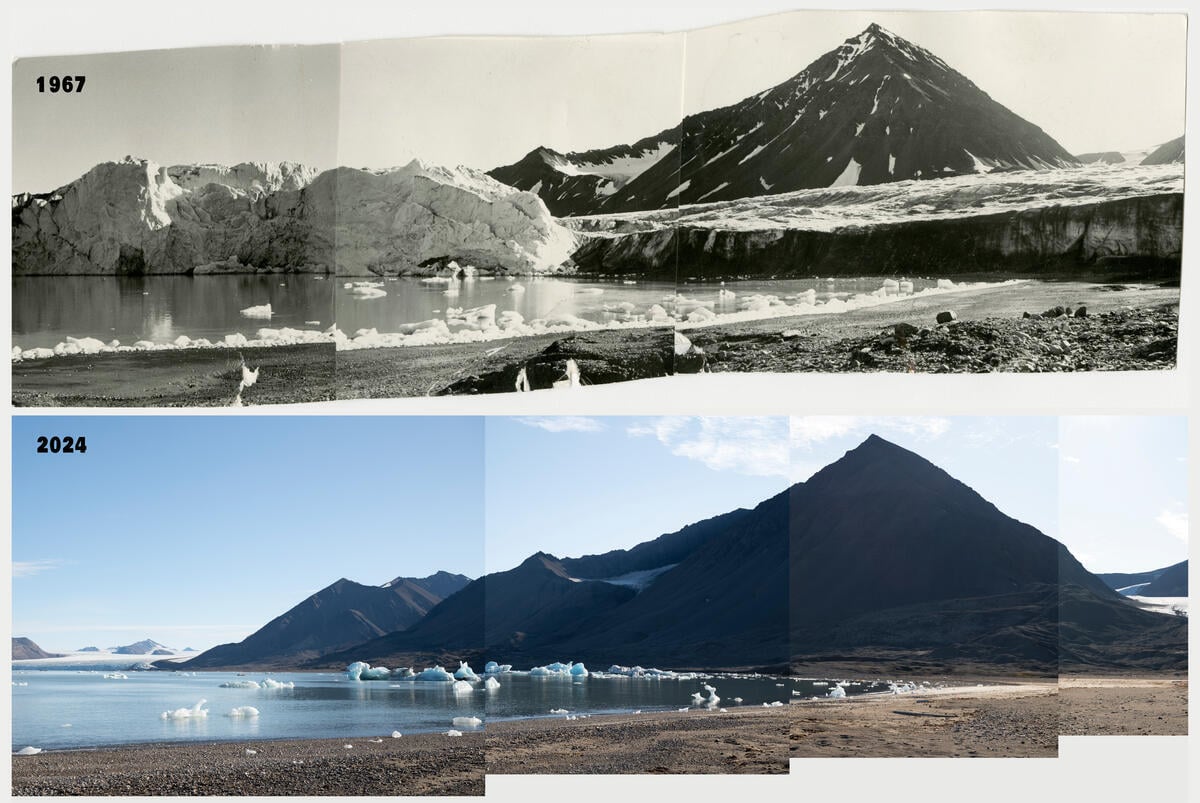 Image contains stitched photos to create a panorama, showing the Kongsvegen and Pedersenbreen glaciers merging and surrounding the mountain of Nielsenfjellet outside Ny Ålesund, Svalbard.
Image contains stitched photos to create a panorama, showing the Kongsvegen and Pedersenbreen glaciers merging and surrounding the mountain of Nielsenfjellet outside Ny Ålesund, Svalbard.Top: Panorama image from the Norwegian polar institute archive, taken in 1967.
Bottom: Panorama taken 24th August 2024.
Norwegian Polar Institute Reference image: NP051260 © Christian Åslund / Norwegian Polar Institute / Greenpeace
Photographer Christian Åslund, often commissioned by Greenpeace, has been working on a project since 2002: focusing on visual research of glaciers in Svalbard in the Arctic and documenting their retreat over time. This work contrasts current images with archival photos from the Norwegian Polar Institute dating back to the early 1900s.
Earlier this year, Christian boarded Greenpeace ship The Witness, to return to revisit some of the glaciers he first captured in 2002, while also documenting new ones for his ongoing project.
In Christian’s own words,
“At so many of the glaciers I photographed for this series, we saw the same story – ice walls completely gone and glaciers retreating back into nothing. They illustrate just how quickly our planet is changing as the climate crisis worsens. The Arctic is our climate sentinel – it’s where the climate and ocean crises converge, and where the impacts of these crises are seen first and felt most keenly.”
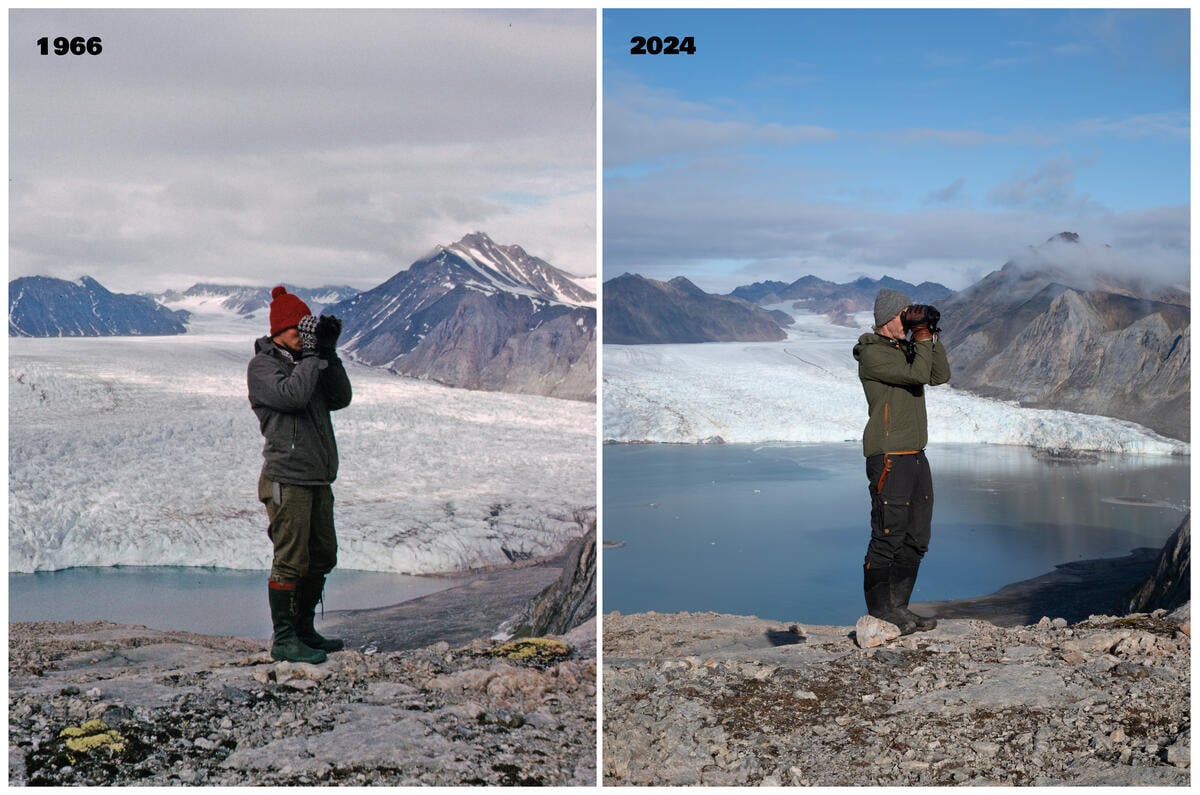 Left: Archive image of a man standing on a peak on the island Blomstrandøya in Kongsfjorden during a research trip in 1966, with the glacier Blomstrandbreen visible in the background. At the time it was thought to be a peninsula, but after the glacier melted it was realised that it was an island. Blomstrandbreen, Ny Alesund, Svalbard.
Left: Archive image of a man standing on a peak on the island Blomstrandøya in Kongsfjorden during a research trip in 1966, with the glacier Blomstrandbreen visible in the background. At the time it was thought to be a peninsula, but after the glacier melted it was realised that it was an island. Blomstrandbreen, Ny Alesund, Svalbard.Right: Image taken in the same location by photographer Christian Aslund, with a Greenpeace crew member in the foreground. On the 23rd August 2024. © Christian Åslund / Norwegian Polar Institute / Greenpeace
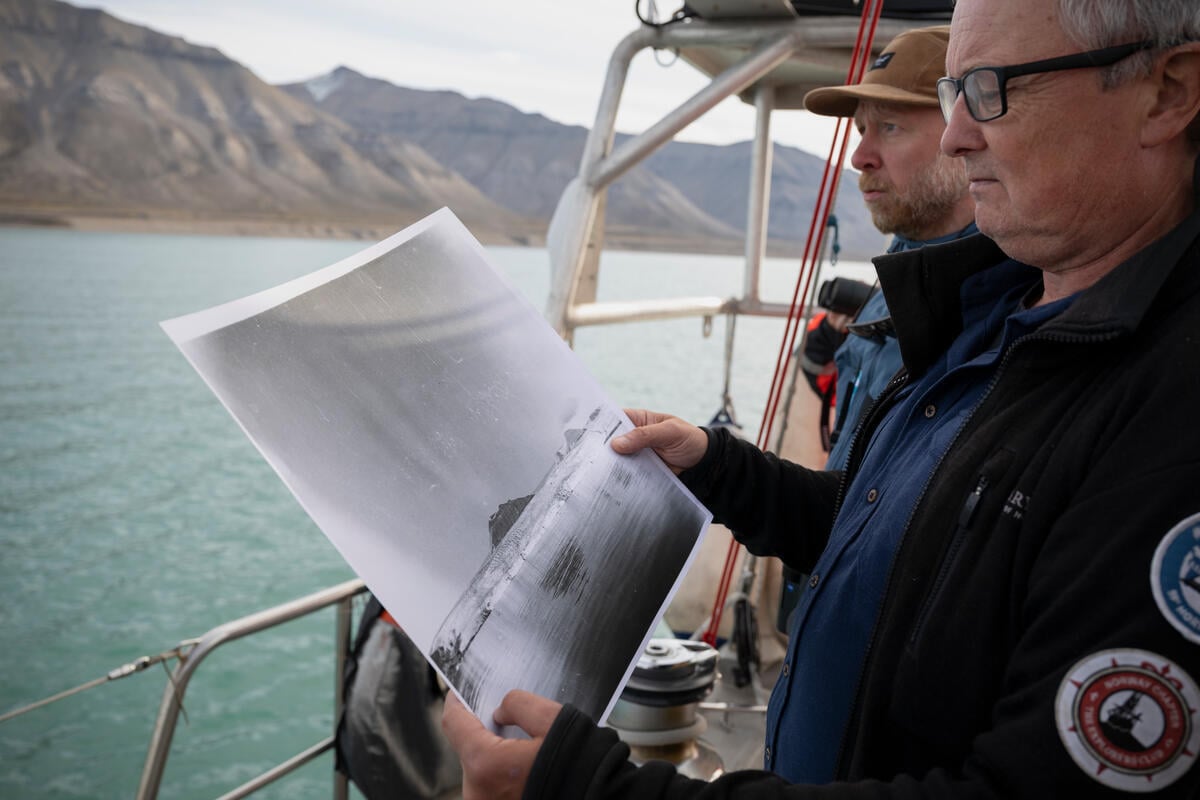 Captain Jon Amtrup of the Greenpeace vessel, witness looks at an archive image from the Norwegian Polar Institute of Nordenskioldbreen from 1961 in Adolfbukta, Billefjorden,. Svalbard. © Christian Åslund / Greenpeace
Captain Jon Amtrup of the Greenpeace vessel, witness looks at an archive image from the Norwegian Polar Institute of Nordenskioldbreen from 1961 in Adolfbukta, Billefjorden,. Svalbard. © Christian Åslund / Greenpeace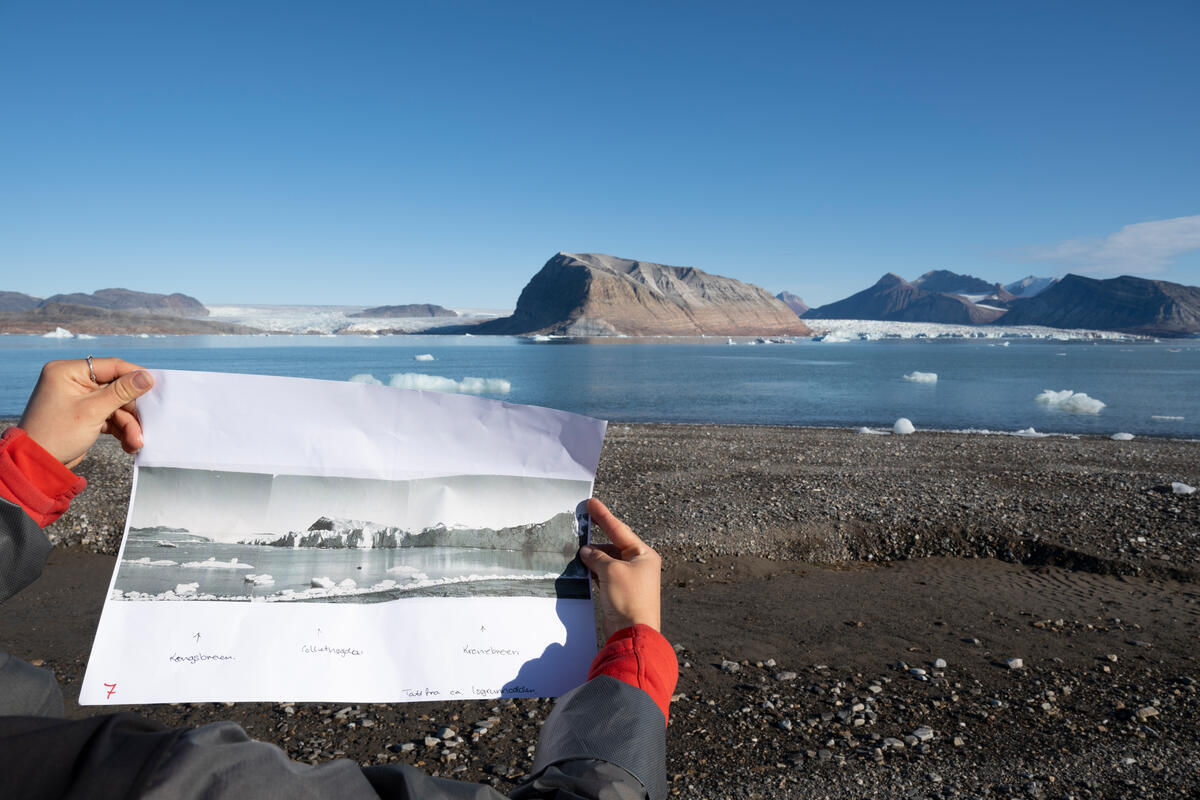 Member of the Greenpeace team holds up a historical panorama image from the Norwegian Polar Institute showing the glaciers Kongsbreen and Kronobreen surrounding Collethøgda Island, outside Ny Ålesund, Svalbard. from 1967 © Christian Åslund / Greenpeace
Member of the Greenpeace team holds up a historical panorama image from the Norwegian Polar Institute showing the glaciers Kongsbreen and Kronobreen surrounding Collethøgda Island, outside Ny Ålesund, Svalbard. from 1967 © Christian Åslund / GreenpeaceIn 2002 the documentation of the iconic Blomstrandbreen glacier showed that the glacier had retreated nearly 2 km since 1928, with an accelerated rate of 35 metres lost per year since 1960 and even higher in the past decade. The shocking images since, only illustrate the terrifying extent to which Arctic glaciers have retreated in the last century.
Glacier comparison images – Blomstrandbreen, Svalbard
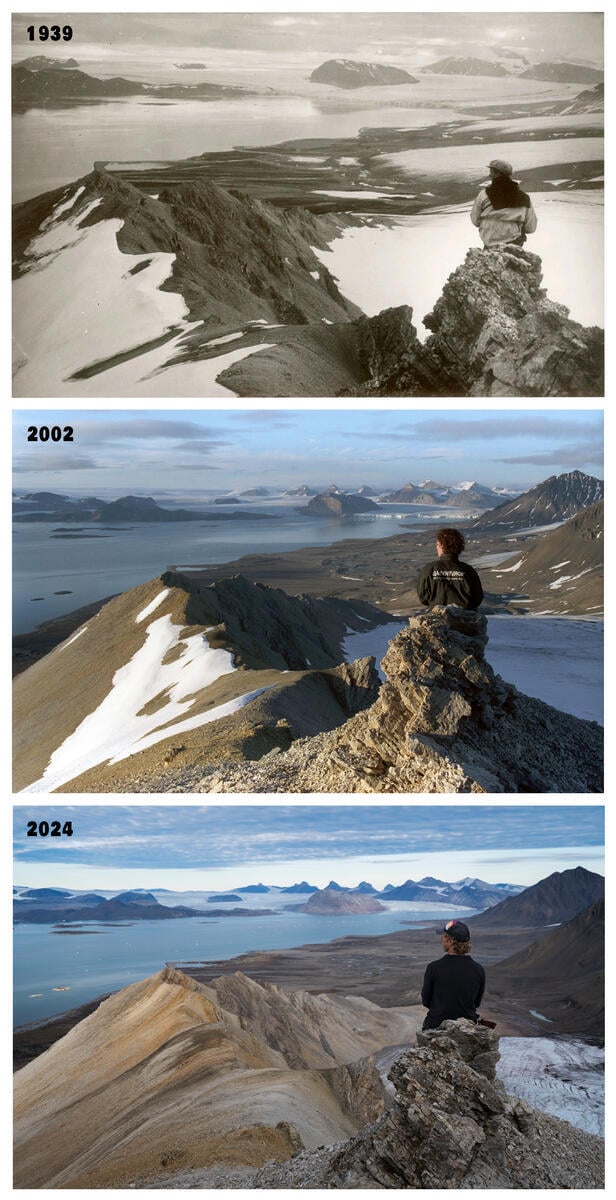 Top: Historical image from the Norwegian polar institute’s archive: glaciers Kronobreen, Kongsbreen and Kongsvegen spreading out in the fjord Kongsfjorden, seen from Mount Zeppelinfjellet, from the year 1939.
Top: Historical image from the Norwegian polar institute’s archive: glaciers Kronobreen, Kongsbreen and Kongsvegen spreading out in the fjord Kongsfjorden, seen from Mount Zeppelinfjellet, from the year 1939.Middle: taken from the same position with Greenpeace crew member in the foreground in 2002.
Bottom: taken from the same position with Greenpeace crew member in the foreground 24th August 2024 © Christian Åslund / Norwegian Polar Institute / Greenpeace
Glacier comparison images – Ny Alesund, Svalbard
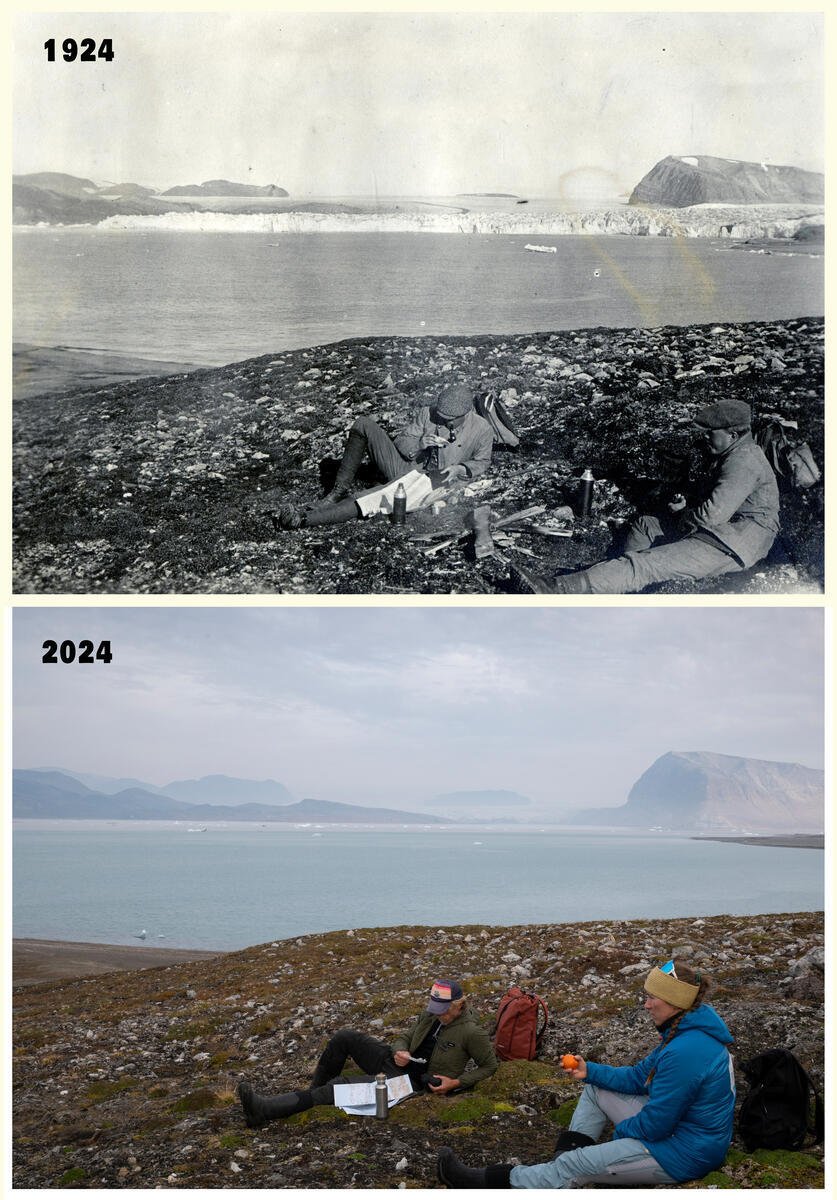 Top: Historical image by geologist Anders K. Orvin in 1924, with the glaciers Kongsbreen, Kronobreen and Kongsvegen surrounding Collethøgda Island.
Top: Historical image by geologist Anders K. Orvin in 1924, with the glaciers Kongsbreen, Kronobreen and Kongsvegen surrounding Collethøgda Island. Bottom: Image taken at the same location by photographer Christian Aslund. 26th August 2024 © Christian Åslund / Norwegian Polar Institute / Greenpeace
The rapid warming of the Arctic has significant global consequences. Melting glaciers and ice sheets contribute to rising sea levels, while the loss of sea ice exposes a darker ocean that absorbs heat rather than reflecting it, leading to widespread changes in weather patterns. The climate and ocean crises are deeply intertwined; as the climate crisis intensifies, the ocean’s capacity to mitigate its most severe effects, support coastal communities, and sustain marine ecosystems is being undermined at an unprecedented scale.
Glacier comparison images – Kongsbreen
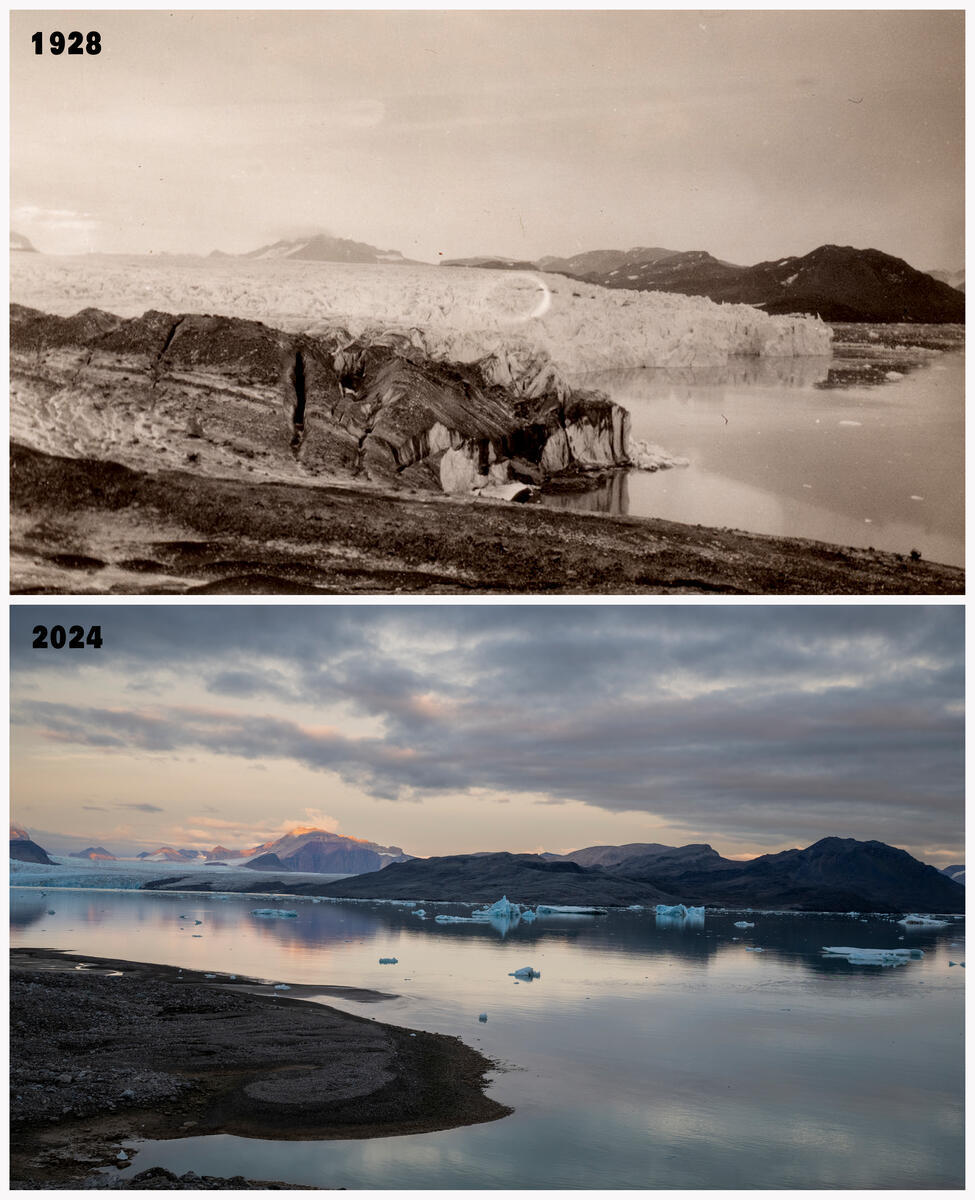 Top: Historical image from 24.08.1928 from the Norwegian Polar Institute, of the glacier Kongsbreen.
Top: Historical image from 24.08.1928 from the Norwegian Polar Institute, of the glacier Kongsbreen. Bottom: taken from the same position 23 August 2024. © Christian Åslund / Norwegian Polar Institute / Greenpeace
Glacier comparison images- Nordenskioldbreen
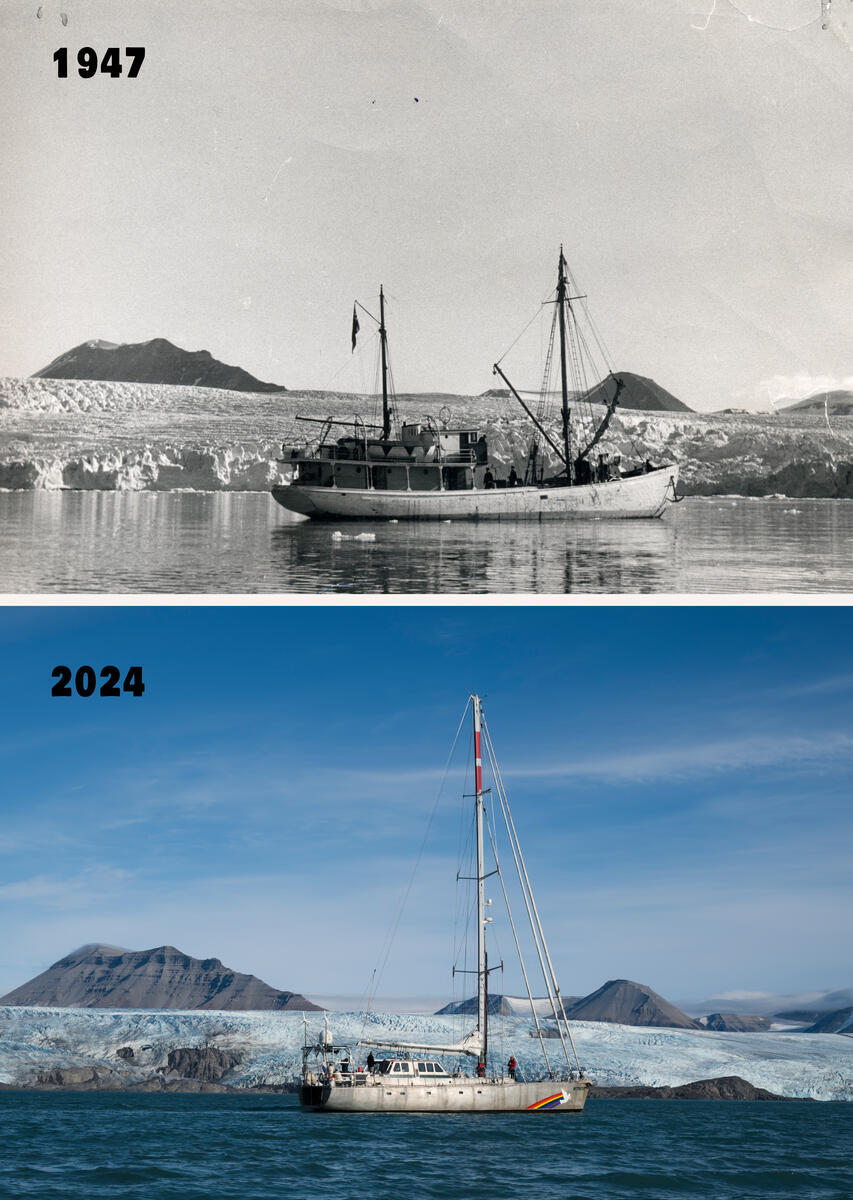 Top: Archive image from 1947. Norwegian Polar Institute of the ship Minna in the bay Adolfbukta in front of the Nordenskioldbreen glacier in Svalbard.
Top: Archive image from 1947. Norwegian Polar Institute of the ship Minna in the bay Adolfbukta in front of the Nordenskioldbreen glacier in Svalbard.Bottom: Image taken by photographer Christian Aslund, on the 17th August 2024, from the same location with the Greenpeace vessel, Witness in the foreground.6 © Christian Åslund / Norwegian Polar Institute / Greenpeace
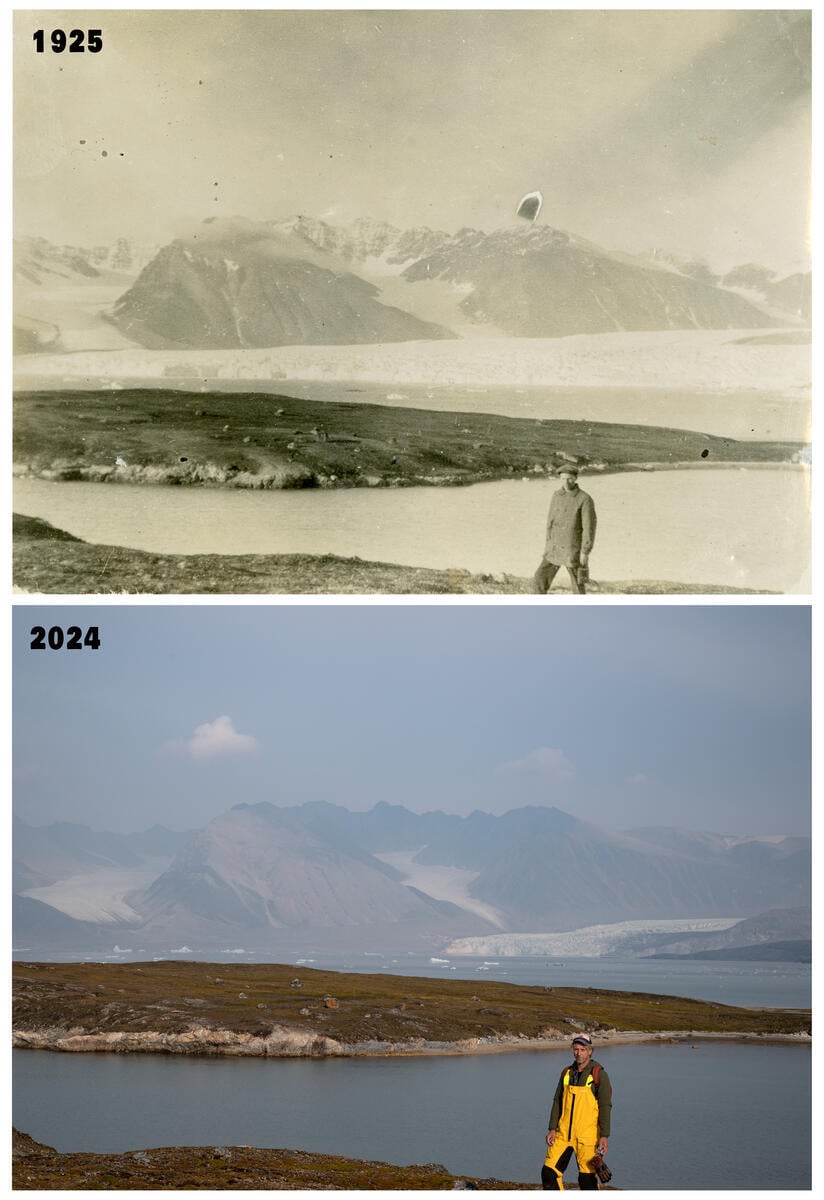 Top: Historical image from Norwegian Polar Institute’s archive showing the Conwaybreen glacier, taken in 1925. NY-Alesund, Svalbard.
Top: Historical image from Norwegian Polar Institute’s archive showing the Conwaybreen glacier, taken in 1925. NY-Alesund, Svalbard.Bottom: Photo taken from the same position, 23rd August 2024. © Christian Åslund / Norwegian Polar Institute / Greenpeace
Glacier comparison images – Tempelfjorden
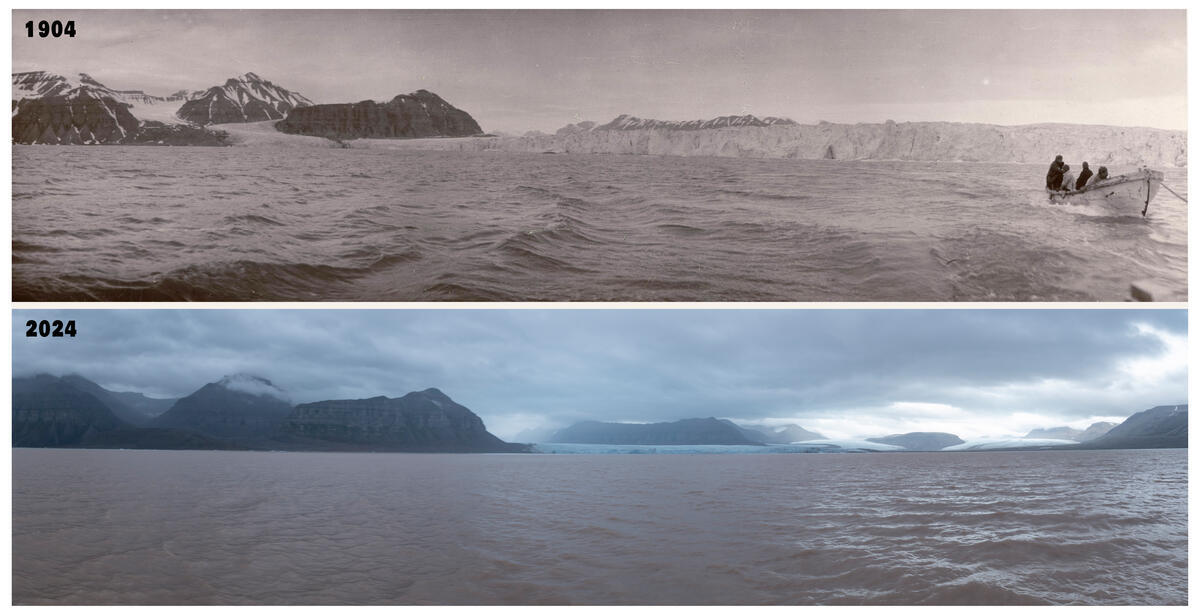 Top: Archive image from the Norwegian Polar Institute from Tempelfjorden, Svalbard. Taken in 1935 and facing the glacier von Postbreen.
Top: Archive image from the Norwegian Polar Institute from Tempelfjorden, Svalbard. Taken in 1935 and facing the glacier von Postbreen. Bottom: Taken by Christian Aslund from the same position: using multiple exposures to create a panoramic image. 17th August 2024. © Christian Åslund / Norwegian Polar Institute / Greenpeace
Glacier comparison images – Kongsfjorden, Svalbard
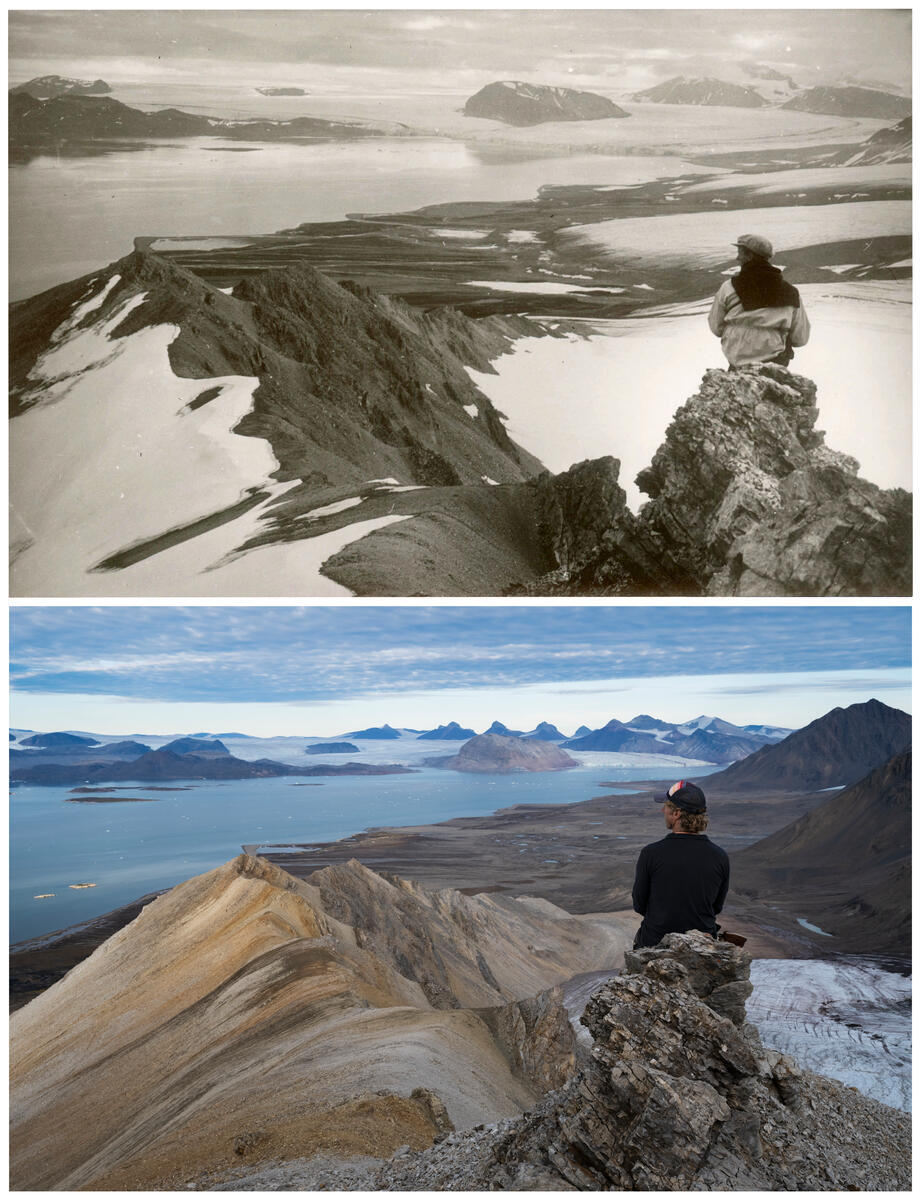 Top: Historical image from the Norwegian polar institute’s archive: glaciers Kronobreen, Kongsbreen and Kongsvegen spreading out in the fjord Kongsfjorden, seen from Mount Zeppelinfjellet, from the year 1939.
Top: Historical image from the Norwegian polar institute’s archive: glaciers Kronobreen, Kongsbreen and Kongsvegen spreading out in the fjord Kongsfjorden, seen from Mount Zeppelinfjellet, from the year 1939.Bottom: taken from the same position with Greenpeace crew member in the foreground 24th August 2024 © Christian Åslund / Norwegian Polar Institute / Greenpeace
Glacier comparison images – Lovénbreen
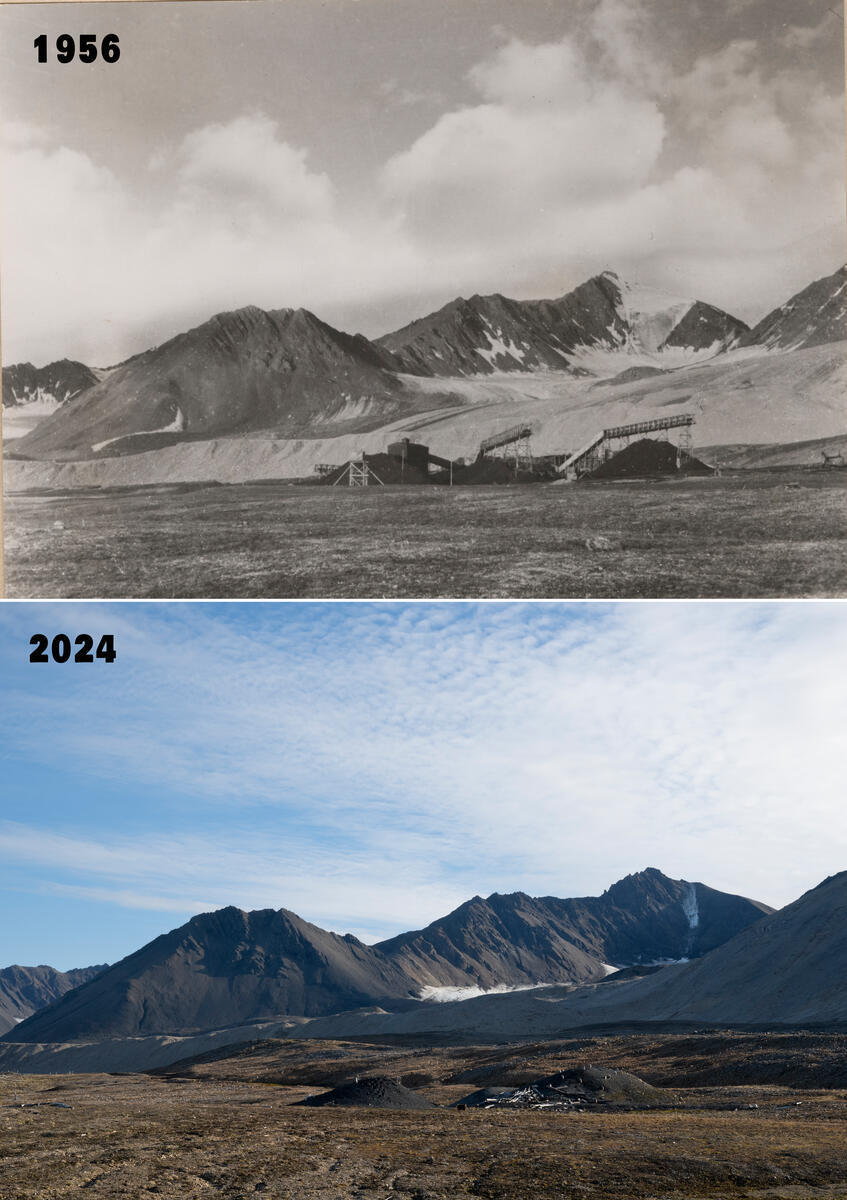 Top: Historical image from the Norwegian Polar Institute’s expedition to Svalbard, the summer 1956 showing an old coal mine. and the glacier Lovénbreen. Ny Alesund, Svalbard.
Top: Historical image from the Norwegian Polar Institute’s expedition to Svalbard, the summer 1956 showing an old coal mine. and the glacier Lovénbreen. Ny Alesund, Svalbard.Bottom: Taken by photographer, Christian Aslund from the same position 24th August 2024 © Christian Åslund / Norwegian Polar Institute / Greenpeace
Protecting the oceans is essential. Safeguarding 30% of the world’s oceans by 2030 through a network of ocean sanctuaries. Greenpeace is urging governments to ratify the UN Ocean Treaty by June 2025 to initiate the establishment of sanctuaries in the high seas across at least 30% of the world’s oceans by 2030.

 2 weeks ago
18
2 weeks ago
18

